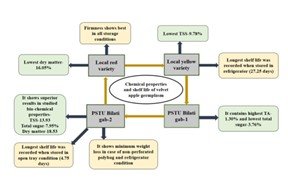Chemical properties and shelf life of velvet apple germplasm
Abstract
The study was undertaken to evaluate bio-chemical properties, shelf-life determination and expansion of ripe fruits of four velvet apple germplasm. The selected germplasm were local red variety, local yellow variety, PSTU Bilati gab-1 and PSTU Bilati gab-2. Ripe fruits were collected from Germplasm Center, Patuakhali Science and Technology University (PSTU) and different locations of Patuakhali district of Bangladesh. Results expressed that maximum TSS (13.93%), vitamin-C (3.68 mg/100g), non-reducing sugar (5.15%) and total sugar (7.95%) were recorded from PSTU Bilati gab-2, the highest TA (1.30%) was found in PSTU Bilati gab-1 but highest pulp pH (7.50) and TSS to TA ratio (11.11) were recorded from local yellow variety whereas highest reducing sugar (3.17%) was recorded from local red variety. The shelf life of ripe fruit varied from 3.25 – 4.75 days where the longest shelf life was obtained from PSTU Bilati gab-2 and the shortest shelf life was recorded in local red variety. But the storability was extended more than 27 days when stored in “Refrigerator” followed by “Non-perforated polybag (NPP)” (10 days), perforated polybag (8 days) and paper bag (6 days). The firmness of fruits were decreased gradually with days but the reduction was minimized when stored in different storage condition where more firmness hold in refrigerator treatment followed by NPP. Similarly, the weight loss was controlled in refrigerator followed by NPP treatment. The results of the experiments revealed that PSTU Bilati gab-2 provides superior chemical properties among the germplasm and ‘Refrigerator’ treatment exhibited best performance among other.
Keywords:
Chemical properties, Germplasm, Shelf life, Velvet appleDownloads
References
Ahmed, M., Mozumder, S. N., Firoz, Z. A., & Faisal, S. M. (2011). Variability and performance of superior velvet apple (Diospyros discolor) germplasm in the hilly region. Bangladesh Journal of Agricultural Research, 36(2), 223-230.
Das, S. C., Hamid, K., Bulbul, I. J., Sultana, S., & Islam, S. (2010). In vitro antioxidant activity of different parts of the plant Diospyros discolor. Research Journal of Agriculture and Biological Sciences, 6, 472-475.
Greuter, W. (2000). International code of botanical nomenclature (Saint Louis Code). Regnum vegetabile, 138, 1-474.
Haque, M. N., Saha, B. K., Karim, M. R., & Bhuiyan, M. N. H. (2009). Evaluation of nutritional and physico-chemical properties of several selected fruits in Bangladesh. Bangladesh Journal of Scientific and Industrial Research, 44(3), 353 -358.
Haque, M. R., Hossain, M. M., & Rahim, M. A. (2020). Morpho-biochemical evaluation of eight Velvet apple (Diospyros discolor Willd.) germplasms. International Journal of Minor Fruits, Medicinal and Aromatic Plants, 6(2), 45 – 55.
Hossain, M. M., Rahim, M. A., & Haque, M. R. (2021). Biochemical properties of some important underutilized minor fruits. Journal of Agriculture and Food Research, 5, 100148.
Kumar, N., & Thakur, K. S. (2018). Extending postharvest storage life of non-astringent persimmon cv. Fuyu by 1-MCP treatments. International Journal of Bio-resource and Stress Management, 9(1), 114-117.
Lane, M. & Etymon, F. (1923). Physical and chemical characteristics of off ripened mango (Mangifera indica L.) fruit (Dodo). African Journal of Biotechnology, 6(21), 2477 -2483.
Lee, S. E., Hwang, H. J., Ha, J. S., Jeong, H. S., & Kim, J. H. (2003). Screening of medicinal plant extracts for antioxidant activity. Life sciences, 73(2), 167 -179.
Lim, T. K., & Lim, T. K. (2012). Diospyros blancoi. Edible Medicinal And Non-Medicinal Plants: Volume 2, Fruits, 421-424.
Ranganna, S. (1979). Manual of Analysis of Fruits and Vegetables Products, TataMcGrew Hill Publ. Co. New Delhi, 102-140.
Recuenco, M. C., Lacsamana, M. S., Hurtada, W. A., & Sabularse, V. C. (2016). Total phenolic and total flavonoid contents of selected fruits in the Philippines. Philippine Journal of Science, 145(3), 275-281.
Singh, R. (1998). Fruits National Book Trust, A-5, Green Park, New Delhi, India. pp. 200.
Somat, N. A., Yusoff, Z., & Osman, C. P. (2020). Chemical constituents from Diospyros discolor Willd. and their acetylcholinesterase inhibitory activity. Pharmacognosy Journal, 12(6s), http://10.5530/pj.2020.12.212
Yadav, M., Srilekha, K., & Maheswari, K. U. (2018). Potential health benefit of underutilized fruits: A review. Journal of Pharmacognosy and Phytochemistry, 7(5), 1417-1420

Published
How to Cite
Issue
Section
Copyright (c) 2023 Agriculture and Environmental Science Academy

This work is licensed under a Creative Commons Attribution-NonCommercial 4.0 International License.

